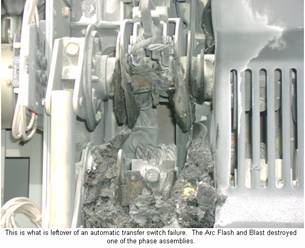OSHA & 70E – Part 1 of 4

By Mel Amundson
This article is the 1st in a series of 4 where I will try to provide a framework for your understanding of how “NFPA 70E and Arc Flash Safety” are affecting our workplace today, and into the future.
- How can OSHA regulations today affect your work as an electrician?
The NFPA 70E was originally developed at OSHA’s request to address electrical hazards in the workplace. OSHA bases its electrical safety requirements on the comprehensive information in NFPA 70E. Even though OSHA does not mandate compliance with NFPA 70E itself, it considers NFPA 70E to be an effective how-to manual for OSHA regulation compliance.
As a general guideline to the content of NFPA 70E, the first chapter is the guidelines for the safety directives we see in the OSHA regulations. You will find that Articles 110 and 120 have become the electrical safety regulations, with 120 becoming the parent of our LOTO programs. OSHA has adopted the NFPA 70E codes through the 2000 codebook. The Article containing the Arc Flash Safety Standards does not appear until the 2002 NFPA 70E codebook as Article 130, and has not been adopted into the OSHA regulation series.
The adoption of the NFPA 70E codes are led by the dangers in our chosen trade, the electrical work place. According to an article by NFPA’s Senior Electrical Specialist Kenneth Mastrullo, “Statistics show that electrical contact results in 4,000 non-disabling and 3,600 disabling injuries annually in the United States, not to mention one death in the workplace every day.” Historically, electrocution has been the fourth leading cause of workplace deaths in America, Mastrullo says. He also points out that two other common electrical hazards “arc flash and arc blast “are not included in these statistics, nor are near-miss incidents.
a. What does OSHA say about protecting you and your workers?
OSHA requires the use of protective equipment when working where potential electrical hazards exist, although the agency does not specify how to select personal protective equipment. OSHA requires the employer to assess workplace hazards and the need for personal protective equipment, but it does not specify how to conduct hazard assessments.
Although OSHA doesn't directly state what to do about arc-flash hazards, OSHA 29 CFR 1910.132(d) (1) requires employers to evaluate the workplace for hazards. And based on these assessments, the employer must select and require the use of appropriate personal protective equipment (PPE) for its employees.
b. How can I distinguish between the electrical work that is considered “general industry work” (OSHA 29 CFR 1926) and electrical work that is considered “construction work” (OSHA 29 CFR 1910).
Article 1910.12(d) states: For the purposes of this part, to the extent that it may not already be included in paragraph (b) of this section, "construction work" includes the erection of new electric transmission and distribution lines and equipment, and the alteration, conversion, and improvement of the existing transmission and distribution lines and equipment.
Article 1910.301(a) states: Included in this category are all electric equipment and installations used to provide electric power and light for employee workplaces.
Within the 1910 article series, the safety design standards for electrical systems are contained in Articles 1910.302 thru 1910.330.
Article 1926.10(a) states: This subpart contains the general rules of the Secretary of Labor interpreting and applying the construction safety and health provisions of section 107 of the Contract Work Hours and Safety Standards Act (83 Stat. 96). Which is for construction, alteration, and/or repair, including painting and decorating, that no contractor or subcontractor contracting for any part of the contract work shall require any laborer or mechanic employed in the performance of the contract to work in surroundings or under working conditions which are unsanitary, hazardous, or dangerous to his health or safety, as determined under construction safety and health standards promulgated by the Secretary by regulation.
Overall CFR 1910 provides for the safe installation and repair of electrical equipment. And CFR 1926 is to make sure of the safety of the construction site and that health standards are also maintained.
Mel Amundson, President of Amstar Electric, is a noted presentor and consultant in the electrical industry.
http://www.mbamundson.com/
70E is all well and good if properly applied. But it only goes so far. The only thing it will do is it will protect you up to and including a 2nd degree burn. The reason for that is a 2nd degree burn is considered curable, while a 3rd or 4th is not
The article quoted 29 CFR 1910.12(d), "For the purposes of this part, to the extent that it may not already be included in paragraph (b) of this section," but left out paragraph (b): ""Construction work" means work for construction, alteration, and/or repair, including painting and decorating." That goes way beyond installing transmission and distribution lines. It's usually not too hard, though, to distinguish construction from maintenance & operations.
I do not believe there was a NFPA 70E 2002. There was a 2000 and a 2004. The NFPA 70 2002 (National Electrical Code) makes mention of 70E in 110.16.
The 1910 is the General Industry Standard and the 1926 is the Construction Standard for OSHA. I believe these were backward in the article.
This first article gives a good overview of how NFPA 70E came to us as a "how to" guide.
I have had the pleasure of attending a Ken Mastrullo seminar on this subject on 2 seperate occasions. He has alot of the same qualities as Mike in terms of comming up through the electrical ranks and really relates to his audience.